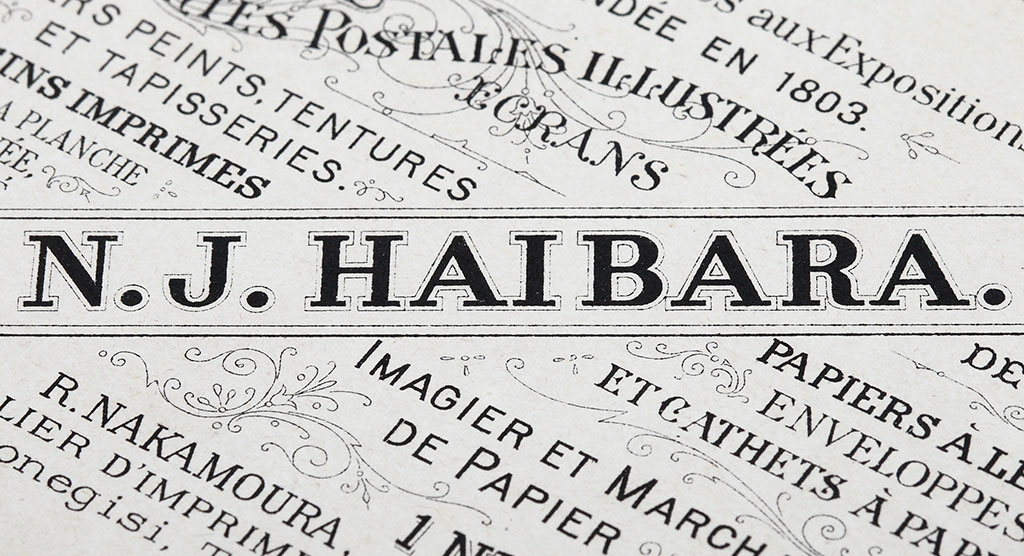Table of Contents
Did you know that Haibara was the first Japanese company to make the official postcards (kansei-hagaki) that we use every day?
We can trace the history of the Japanese official post cards by unraveling the “History of Postage Stamps” (in the collection of the National Institute of Posts and Telecommunications) and “Kobunroku” (in the collection of the National Archives of Japan), which describe the founding period of the postal service.
Japan’s postal service was established in 1871.
Two years later in December 1873, the first official postcard was issued. This postcard was a thin sheet of paper folded in half vertically and mailed without a seal; it was called a “Futatsuori Hagaki” (folded postcard).
There are three types of “Futatsuori postcards,” depending on when they were issued: postcards with a red frame, postcards with “waki” (letterhead), and postcards without “waki”. Haibara was responsible for the production of postcards with and without “waki”).
There were no cell phones, emails, or social networking services during this time period. Within a year and a half of their release, more than 300,000 postcards were sold per month. Postcards, which were easier to send and handier than letters, spread rapidly throughout people’s lives.
Due to the lack of dedicated New Year’s postcards at the time, official postcards produced by Haibara were also used as New Year’s cards.
Following the Western model, the folded postcards were discontinued in 1875 and replaced with the card-style postcards we know today.
In addition to producing official postcards, Haibara also manufactured “postal envelopes” (envelopes printed with a postage stamp) and “express postage stamps” (used by the army for express delivery in times of emergency) in 1874. Around 1880, the company was also given the responsibility of printing and processing “Yuken” (postage stamps).
Haibara’s traditions and techniques, which supported the dawn of Japan’s postal service, continue to be passed down today.
We offer an irreplaceable letter culture that unites people’s hearts and minds through our pleasant and beautifully designed letter sets, postcards, one-page notes, cards, and other products.
Handwritten words are enjoyable to write and even more enjoyable to receive.
Who do you write to, and what do you write about?


Haibara x Letter culture started with rolled paper
The “accordion-fold letter paper” combines functionality and design. What was the inspiration for the idea?
Is it true that rolled paper was used as postcards before the establishment of the postal system?
It is true. Today, when we think of items for writing letters by hand, letter paper and postcards may come to mind. However, these items did not exist until the Meiji period, when the postal service began. Before that time, it was common practice to write letters on “makigami,” a roll of paper, with a brush.
Haibara has been dealing in Japanese paper rolls since its establishment. We have created not only simple paper rolls but also variants of paper rolls according to the times, such as “Gounsen,” a paper made by pasting together exquisite five-colored washi paper, which was proposed by former Prime Minister Shigeru Yoshida, and “Ehankire,” a roll of paper with designs printed on it by woodblock printing. (*At the moment, we do not sell “ehankire”).
Those paper rolls and “ruled paper,” which had been handled since the end of the Edo period, were sized to suit the postal system. This marked the start of letter paper and postcards.
The inspiration for Haibara’s “accordion-folded letter paper” came from traditional folding books of scrolls, sutras, tanzaku (strips of paper), and origami (colored paper).
This distinctive letter paper is accordion-folded, ruled paper with perforations on the accordion folds. The ability to cut off a piece of letter paper according to the length of the letter, combined with the unique elegance of Haibara’s design, has made this product a client favorite.

The paper is made of 100% of Mitsumata plant, which is known by its smooth writing feel and is completed in rolled form.


Go to the product page for letter paper, envelopes, postcards, one-page notes and others.














 Instagram
Instagram facebook
facebook X(旧Twitter)
X(旧Twitter) Youtube
Youtube note
note







